
Italian postcard by Rizzoli, 1937. Photo: Ghergo.
Leda Gloria (1912-1997) was one of Federico Fellini’s favourite film actresses, having a prolific career in the 1930s and 1940s but is also remembered as the wife of Peppone in the Don Camillo films.

Italian postcard by Rizzoli & C., Milano, 1939-XVIII. Photo: Ghergo. Sent by mail in 1940.
Germana Paolieri (1906-1998) was an Italian stage and screen actress. After the war, she also worked for radio and television. As an actress, she flourished between the early 1930s and 1981, while as a film actress she peaked in the 1930s and early 1940s, but also the mid-1950s.
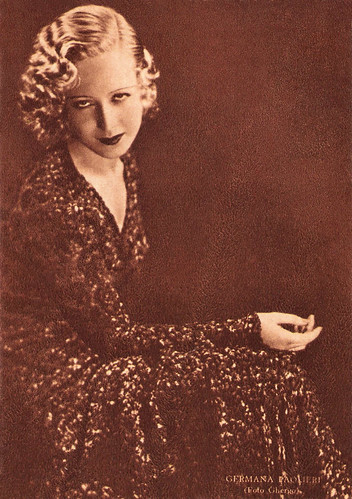
Italian postcard by Rizzoli & C., Milano, 1942-XX. Photo: Ghergo.

Italian postcard by Rizzoli, Milano, 1940. Photo: Ghergo.
Leda Gloria (1912-1997) was one of Federico Fellini’s favourite film actresses, having a prolific career in the 1930s and 1940s but is also remembered as the wife of Peppone in the Don Camillo films.

Italian postcard by Rizzoli, Milano, 1942. Photo: Ghergo.
A beauty which was not necessarily real
Arturo Ghergo was born in 1901 in Montefano in the Italian province of Macerata, the Marche region. At the age of 28, Ghergo moved to Rome in 1929 and opened a photography studio in the highly central location of Via Condotti. Within a few years, he managed to make a name for himself as the most sought-after portrait artist in Rome. His work was much in demand with film stars, politicians, and other personalities from the world of culture.
Above all, Ghergo was in demand by the Rome's high society which was anxious to use every means, including photography, to reaffirm its traditional role at the head of society which a new phase in history was in danger of calling into question, and which very often lent its prestige to the then embryonic fashion industry.
Ghergo was a pioneer of fashion photography in Italy. His photos are testimonials for the exclusive creations of the emerging fashion houses Fontana, Gabriella Sport, Galitzine, Simonetta, Carosa, and Gattinoni. The models of the day, carrying the grand-sounding names of the "beau monde", included a very young Marella Caracciolo long before she was married to Fiat's Giovanni Agnelli, or Consuelo Crespi, Mary Colonna, Josè del Drago and Irene Galitzine.
But above all, it was the world of the cinema that placed the exaltation of its photogenic qualities in Ghergo's hands. In the years in which Italy was setting off, down the path of self-sufficiency in the celluloid industry, the country's film stars were determined to use Ghergo's skilled lens to ensure that the Italian filmgoing public did not miss the celebrities from across the Atlantic.
From Isa Miranda to Mariella Lotti, Leda Gloria, Alida Valli, Marina Berti, Assia Noris, Maria Denis, Valentina Cortese, Clara Calamai, Paola Barbara, Amedeo Nazzari, Massimo Girotti and right on into the 1950s with Sophia Loren, Silvana Pampanini, Gina Lollobrigida, Silvana Mangano and Vittorio Gassman and an endless list of aspiring starlets, all transfigured by Ghergo's touch into sophisticated demigoddesses.
A connoisseur of perfection and a professional with impeccable taste, Ghergo invented his own style of sophisticated classicism, carefully constructed without fear of experimentation, through diagonal cuts, disorienting dissonances and refined illuminations. Ghergo's iconographic formula ensured that he was to enjoy a practically unchanged reputation and immense public consideration right up to his premature death in 1959.
Even as fashions changed and as new forms of expression were being introduced and tested with colour photography, advertising and painting, Ghergo remained essentially loyal to his style, continuing to evince his own personal and unfaltering allegiance to the cult of beauty - a beauty which was not necessarily real, which may have been the result of a chemical and physical recording process in analogue mode, but which was laboriously and meticulously constructed with the contrived, exalted and inspiring light that lay more in Ghergo's mind than in his sitter's features.
He also worked in advertising and painting. In the 1950s, Ghergo created paintings, influenced by Pablo Picasso's cubism and his futurist and cinematographic experience. He combined in his paintings the instinctive search for framing, typical of his craft, with the exaltation of a visual layout of broader direction, typical of painting.
From 3 April to 8 July 2012, the Palazzo delle Esposizioni in Rome presented the exhibition 'Arturo Ghergo - Fotografie 1930-1959' (Arturo Ghergo. Photographs 1930-1959), with over 250 photographs by Ghergo. The exhibition was curated by Ghergo's daughter, Cristina Ghergo.

Italian postcard by B.F.F. Edit. (Casa Editr. Ballerini & Fratini, Firenze), no. 2069. Photo: Ghergo.
María Denis (1916-2004) was one of the most popular stars of Italian cinema under Fascist rule. Very successful were her Telefoni Bianchi films of the 1930s. Charges of collaboration tarnished her career after the war. Controversial were her claims that she had not been the mistress of Nazi police chief Pietro Koch and just used his infatuation with her to help anti-fascists get released, especially film director Luchino Visconti.

Italian postcard by B.F.F. Edit. (Casa Editr. Ballerini & Fratini, Firenze), no. 2070. Photo: Ghergo.
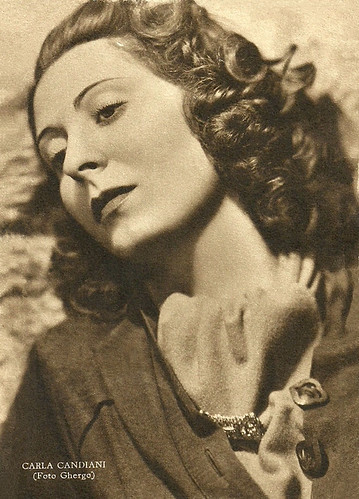
Italian postcard by Rizzoli & C., Milano, 1941. Photo: Ghergo.
Carla Candiani (1916-2005) was an Italian film actress. Discovered by the Italian public in Raffaello Matarazzo's thriller Albergo degli assenti (1939), she took part in seventeen films during her career, from the late 1930s to the late 1940s.

Italian postcard by B.F.F. Edit. (Casa Editr. Ballerini & Fratini, Firenze), no. 2080. Photo: Ghergo.

Italian postcard, no. 172. Photo: Ghergo.
Handsome, manly Italian actor Massimo Girotti (1918-2003) had a career that spanned seven decades. He is best remembered for three roles: the young wanderer Gino in Luchino Visconti's Ossessione (1943), the stern lover in Michelangelo Antonioni's Cronaca di un amore (1950) and the passionate patriot in Visconti's Senso (1954).
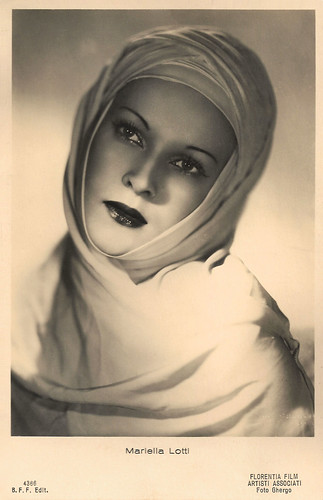
Italian postcard by B.F.F. Edit. (Casa Editr. Ballerini & Fratini, Firenze), no. 4365. Photo: Ghergo / Florentia Film Artisti Associati. Mariella Lotti in La Gorgona/The Gorgon (Guido Brignone, 1942).
Blonde Italian film actress Mariella Lotti (1921-2006) played leading ladies in a number of Fascist-era and post-war films. The refined beauty quickly became one of the most popular Italian divas of the 1940s.
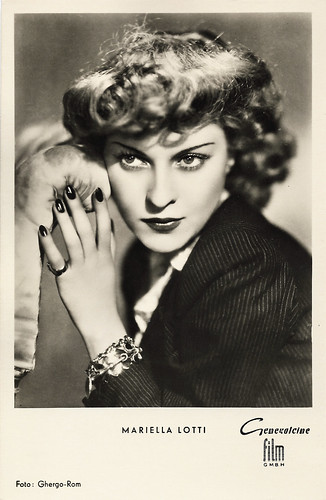
German postcard by Kunst und Bild, Berlin, no. A 570. Photo: Ghergo, Rome / Generalcine Film. Mariella Lotti in La donna che inventò l'amore/The Woman Who Invented Love (Ferruccio Cerio, 1952).

Italian postcard by ASER (A. Scarmiglia Edizioni Roma). Photo: Ghergo.
Paola Barbara (1912-1989) was an Italian actress who acted in over 60 films but also worked on stage and on television. She is best known for the film La peccatrice (1940) by Amleto Palermi.
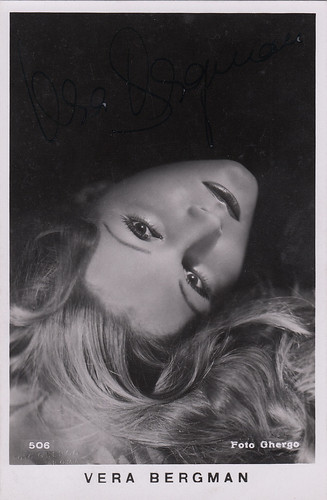
Vintage postcard, no. 506. Photo: Ghergo. Collection: Marlène Pilaete.
Vera Bergman (1920–1971) was the daughter of a German diplomat who became a star in Italian films in the 1940s.
Sources: Palazzo delle esposione, Arte (Italian), and Rome Luxury Blog.
No comments:
Post a Comment